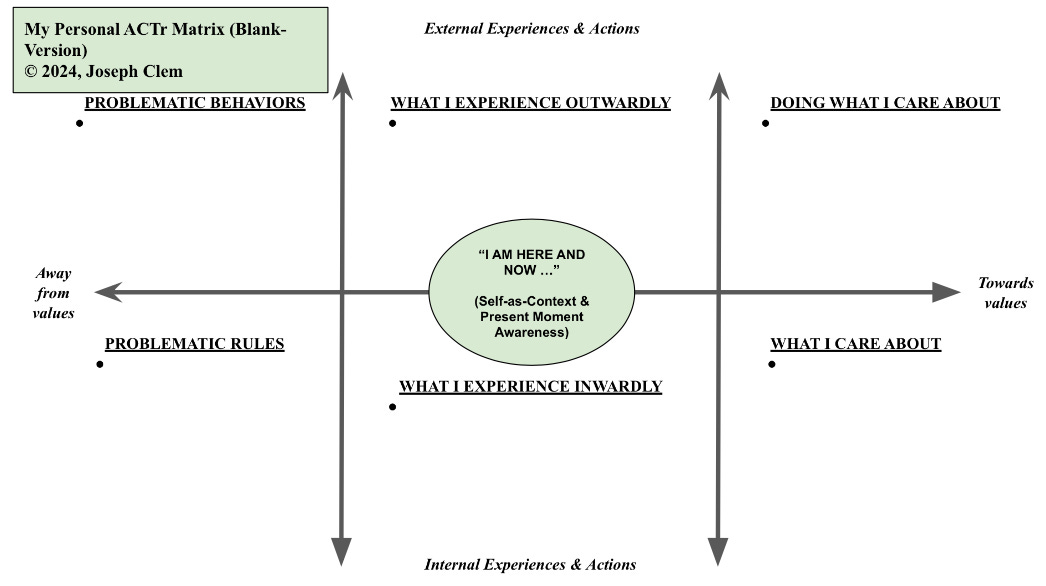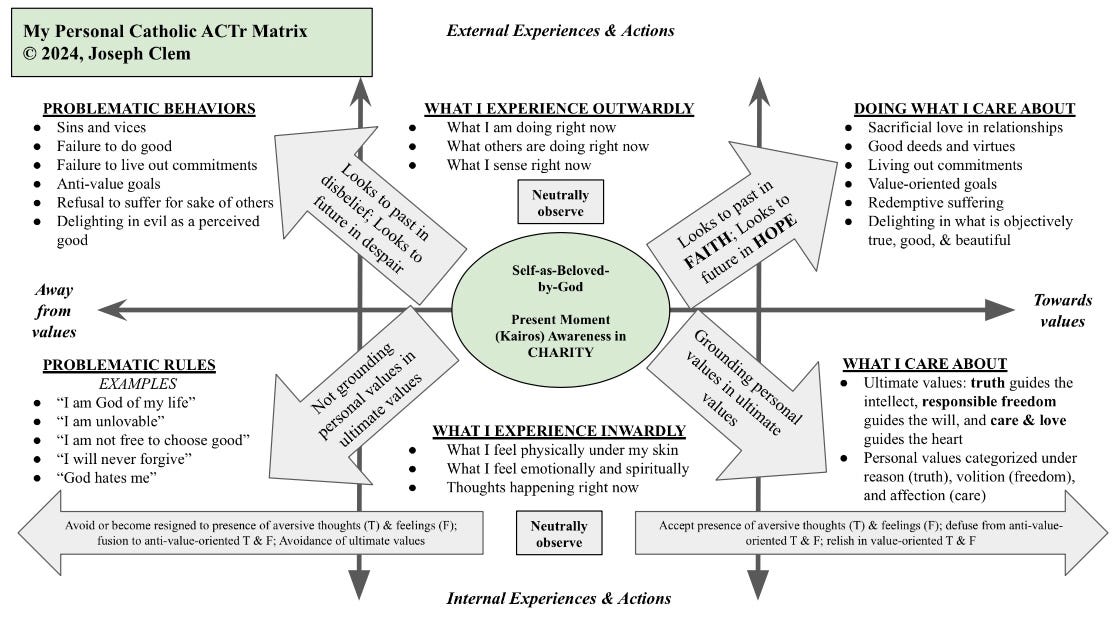My Personal ACTr Matrix (Part III)
Committed Actions as Virtues, the "Dark Side" of the Matrix, & Putting It All Together

Committed Actions as Virtues Within the Moral Law
So much of this Catholic perspective described thus far may be controversial or downright unacceptable to those entrenched in the underlying philosophy of ACT beyond just the application. The idea of actions having moral weight might as well be heresy in the wider field of all behavioral sciences. What is good, after all? What is morality? What is truth? What is your and my truth? What is sin? Isn’t everything determined anyways? No one really chooses to do something. It’s all an illusion.
For Catholics, our freely willed behaviors can be coined as “good” or “evil” insofar as they are proper and fitting to our human nature (and that we even have a human nature beyond our mere biology). I know it can sound unnecessary or antiquated to describe actions as “evil,” but that is the traditional word to describe something that is lacking or distorting goodness. This is part of how Catholics determine whether an action is “moral” versus “immoral.”
Furthermore, actions are measured up against a moral code that is outside of ourselves yet calling us from within. God does speak to our conscience insofar as it is well formed in communicating the natural law which God has written upon our hearts.
Now, committed actions … I think this element of ACT is actually one of the greatest contributions to the field of mental health, even more than the mindfulness elements. This is because (and I am very biased on this point) committed actions are most akin to Applied Behavior Analysis (ABA). The powerful contribution I see is how to measure behavior. How often are counselors taking data or having clients take data on measurable behaviors, whether they are outward and observable to others or they are inward and only observable to the self (i.e., frequency of certain thoughts or rating intensity of emotions)? There are counselors, psychologists, etc. who do this, but I think the measurement of observable behaviors and personal experiences in ABA is a major boon to the mental health field. Are you taking data on your committed actions?
Committed actions can be rule-governed (i.e., following clearly stated personal values) without ever having received some kind of reinforcer beyond telling yourself, “I’m following my value(s).” Committed actions can also have some contingencies in place for receiving immediate or somewhat delayed reinforcers. In fact, the most popular curriculum I know of (and use) for applying ACT with kids is the Accept.Identify.Move (AIM) Curriculum, and it recommends use of a point system with backup reinforcers (i.e., tangible items and activities) which can be acquired by cashing in points. In most ABA programming, a major job of the behavior analyst is to help a child move from being motivated solely by things and activities to receiving social praise and interactions. However, ACT and the AIM Curriculum take it a step further: to move a child’s motivation to “doing what I care about” (values).
The grit to keep doing what we care about is virtuous! More specifically, virtue is the habit or predisposition to do good. One good deed does not make a virtue – only the habit of doing good. Hence, a series of committed actions over time and a habit of doing them (even the habit of doing the Catholic mindfulness activities) can all be called virtues. Imagine if a client was introduced to “desensitization training” as “courage-building,” “fortitude-strengthening,” or “resilience-empowerment.”
The “Dark Side” of the ACT Matrix
One thing that has bothered me recently looking at the current ACT Matrix is seeing that thoughts and feelings are always on the side moving “away” from pain, aligned to behaviors that are away from committed actions and values. This seems to limit the ACT Matrix to thoughts and feelings which have been predetermined to be the object of defusion (“cognitive distancing) whether we add moral weight to them or not. I felt that having a middle section in which there could be a neutral observing with subsequent judging what to accept and what to defuse would be helpful.
Although the ACT Matrix was designed with “away” as describing movements away from pain, the Choice Point tool from Dr. Russ Harris provides a model of choosing “towards values” vs. “away from values.” Thank you, Steven Hryniewicz, for making me aware of this distinction between the tools. What is “away from values?” If I am moving away from being a more present husband and father, what am I moving toward? Yes, I am moving away from my value, but I am also moving toward something or someone, even toward myself. As a Catholic, I’m not shy about discussing morality, goodness, and evil. I call this the “Dark Side” of the ACT Matrix.
On this “dark side” we can see the opposites of our values. I think it can be helpful to name our enemies. For one, calling out our own struggles in openness with others is therapeutic. This includes us being honest with ourselves. Having this “dark side” in the ACT Matrix allows us to label our own problematic behaviors as aligned to “anti-values.” Yes, this sounds “judgy” to some and possibly the reader, but if it is done in the context of a non-judgmental, therapeutic relationship and with a self-as-beloved-by-God perspective, then we can put away our self-hatred with this honest examination of conscience. Contrition for our wrong-doing is not self-hatred. Responsibility for our actions is not injustice or unfair. Taking a truthful look at how our problem behaviors hurt others and how they are aligned to the opposite of our values is not incongruent with psychological and behavioral health. Remember, the light shines brighter in the dark.
There is a risk in trying to fight this “enemy” within. This approach of attacking is not the ACT way. It is also not the Catholic way. Jesus conquers the true Enemy (the Devil who does exist) while loving us in our brokenness and desiring our healing and holiness. The intersection of the ACT approach and the Catholic approach is that we can sit with our thoughts and feelings with God while He sheds His light on what is going on internally. If we try to stuff down our thoughts and feelings with our own will, we will lose. We need to practice a Catholic mindfulness that peacefully looks upon ourselves with God’s mercy and love, that listens patiently to the different “parts” ourselves as an observing self-as-beloved-by-God, that accepts our crosses and moves forward in truth, freedom, and care.
What would anti-values be? In a behavior-analytic conceptualization, they are “rules,” just like values, except that they govern problematic behaviors both overtly and covertly (only observable to the self). Starting with ultimate values, we can surmise there are ultimate anti-values: lies, self-imprisonment, and selfishness (Azcárate, 1979). “I cannot tell the truth because others will punish me.” “I cannot break this habit because I need it.” “I cannot give my time and energy to others because I won’t have enough for myself.” Other problematic rules to which we might behave accordingly might include:
“I mess up everything.”
“No one loves me.”
“If someone really knew me, they would hate me.”
“I’m stupid.”
“Everyone is out for themselves.”
“There is no free will.”
“There is no God.”
Everyone is a philosopher, whether they see themselves as one or not,1 and everyone acts according to their philosophy which may or may not be the one they purport to follow. Problematic behaviors, which are accounted for in the original ACT Matrix, strengthen the evocative control of problematic rules because the behaviors are often reinforced by powerful, short-term reinforcers (whether the addition or subtraction of something — positive vs. negative reinforcement). What philosophy (i.e., rule, value) is actually affecting your behavior for better or worse?
Putting It All Together
I was trying to fill out an ACT Matrix for myself, but what ended up happening was a series of attempts to reconcile my Catholic beliefs with the demonstrably effective ACT Core Processes. The result was creating my own personal ACTr Matrix that mapped out these processes in a way that was workable for me (i.e., without compromising my values). Below is a blank template. I am not sharing this for clinical use, but in order to propose a possible, future alternative for how to conceptualize present moment awareness (i.e., of bodily experiences and environmental contexts) as distinct from escape-avoidance behaviors, and how internal thoughts and feelings are distinct from anti-values (so that we can truly observe thoughts and feelings from a starting point of neutrality to be followed by reasoned discernment if it is aligned to values or anti-values).
Below is my unapologetically Catholic perspective on how the ACT Core Processes work for me in my life. Again, this is an example of how Catholic clients may decide for themselves to receive Acceptance and Commitment Therapy (or Training) if you are using that model. Behavior analysts have an ethical responsibility to “actively engage in professional development activities to acquire knowledge and skills related to cultural responsiveness and diversity” (BACB Ethics Code #1.07) – that includes Catholics and other Christians. My hope is that this is a catalyst for critically examining how hospitable and respectful a clinician should be to Christian clients.
Does your faith background give similar or different interpretations of the ACT Core Processes and how you would practically use the ACT Matrix?
May God bless you for reading (or even skimming) this far.
Sincerely,
The Catholic Behavior Analyst
If you liked this article, please consider sending $1 or more to my wife, Rachel. Any donations go directly to her because she is the one who makes sacrifices for me to write. You can Venmo her at @Rachel-Clem-2
Bio & Disclaimer:
Joseph (Joey) Clem is a Catholic licensed behavior analyst in Virginia. He is a husband, father, and lifetime full member in Youth Apostles. He works primarily with children diagnosed with Autism and volunteers in youth ministry. This article does not constitute professional advice or services. All opinions and commentary of the author are his own and are not endorsed by any governing bodies, licensing or certifying boards, companies, or any third-party.
REFERENCES
Azcarate, E. M. (1979). Stages of Maturation vs. Estrangement [chart]. Revision of adding stage titles and age ranges by Joseph Clem, 2022. Youth Apostles: McLean, VA
Behavior Analyst Certification Board. (2020). Ethics code for behavior analysts. https://bacb.com/wp-content/ethics-code-for-behavior-analysts/
I believe I first heard this from Dr. Peter Kreeft




